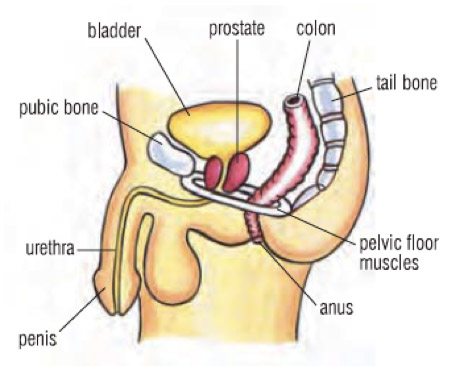The prostate, bladder and urethra:
The prostate gland is about the size of a walnut and sits just below the bladder. It’s main role is to produce fluid that protects sperm and is ejaculated as sperm through the urethra. The urethra is the tube that runs from the bladder, through the prostate and is the pathway for urine and semen to exit the body.

What is Urinary Incontinence:
It is the accidental leakage of urine and may be experienced by the majority of men following surgery for prostate cancer. For some men they will experience no leakage or very mild small amount of leakage that is quickly resolved. For others, the leakage can be more pronounced and last for a much longer period of time. 85%-90% of men will be dry (pad free) by 12 months.
Types of Urinary Incontinence:
- Stress urinary incontinence: this is the involuntary loss of urine with coughing, sneezing, bending over, jumping. Ie with an increase in intra abdominal pressure
- Urge urinary incontinence is the sudden intense need to urinate without the ability to delay, resulting in the loss or leaking of urine before you reach the toilet. Urgency or urge incontinence occurs when your bladder is overactive or contracting without you wanting it to.
- Mixed incontinence is a combination of urinary problems related to both stress and urge urinary incontinence.
Why does it occur after prostate cancer surgery?
Surgery for prostate cancer may cause harm to a muscle that sits at the base of your bladder, causing it to weaken and therefore, it is unable to hold urine in the bladder as efficiently as it previously did.
What treatment can help?
The good news is that for the majority of men, pelvic floor training can greatly improve if not cure urinary incontinence.
Ideally, the exercises are started before surgery, but they can also help bladder control if started after surgery.
What are the pelvic floor muscles?
The pelvic floor is a round layer of muscle at the base of the pelvis. They support the pelvic organs (bladder and rectum) and control the openings of the bladder and bowel. The pelvic floor muscles also play a role in gaining and maintaining erections. The muscles that control the bladder are especially important after prostate surgery.
Finding the pelvic floor muscles.
Sit on your hands and find the sitting bones in the middle of each buttock. The pelvic floor muscles stretch between them. Now stand up and find the pubic bone, at the base of the penis, and the coccyx (tailbone), at the bottom of the spine. The pelvic floor muscles extend from front to back and from side to side between these bones, forming a supportive layer. When tightened, the muscles lift the bladder and bowel inside the pelvis; they shorten the penis and close the anus (back passage). When urinating, contracting the pelvic floor muscles should stop the flow of urine.
How to contract your pelvic floor:
• Imagine you are going to the toilet and mid stream you want to stop the flow
• Imagine you are walking into the ocean and you want to lift your testes up away from the cold water (nuts to guts)
• Try and draw your penis back toward your spine (like trying to draw a telescope in)
• Once you have located your pelvic floor muscles you need to practise:
- 10 x 10 squeeze and lift ( if you can’t do 10 in a row, do as many as you can, rest, repeat)
- 10 x 10 sec hold (if you can’t hold for 10 sec, hold as long as you can and build up to 10 sec), keep breathing normally (rest for 10 seconds in between each one)
- Do these exercises 3 x day: lying down, sitting and standing
- Develop a habit of always contracting your pelvic floor prior to cough/sneeze/lifting/bending.
• Once they are stronger and co-ordinated, do them once a day for maintenance
How do I know I am doing them correctly?
• you will feel a lift sensation (tightening of the testicles/retraction of the penis) and a letting go as you relax
• stand in front of the mirror and you should be able to see your penis gently move up/down
• keep your abdominals and buttock muscles relaxed
• breathe normally throughout the exercise
• if you are not sure that you are contracting the correct muscles, see a pelvic floor physio to give you some feedback
How can a physio help?
A pelvic health physio has training in the pelvic floor and issues relating to pelvic floor dysfunction.
Using real time ultrasound, your physio will assess your ability to activate your pelvic floor muscles and will be able to prescribe an exercise regime that is best suited to your ability and control. This will also give you the confidence that you are activating the correct muscles. Your physio will progress your exercise program as you gain strength, to help you gain control in all areas of life.
What else can contribute to urinary incontinence and pelvic floor weakness?
- Being overweight
- Constipation
- Prolonged heavy lifting
- Prolonged coughing
What else can I do to help?
- Keep your weight down
- Exercise regularly
- Manage constipation (your pelvic health physio can help with this)
- Speak to your GP regarding hayfever and chronic coughing
It can be very challenging coping with the side effects of surgery that include incontinence. It may cause feelings embarrassment, anxiety, frustration and social isolation. Fear of leakage can be enough to stop men from taking part in their normal social activities.
It is important to know that urinary incontinence can be greatly improved and in most cases cured, so it is important to reach out. Your GP is a good place to start. And of course your pelvic health physio!



No Comments